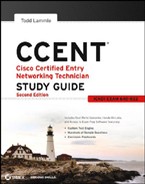Exam Essentials
Understand the IEEE 802.11a specification. 802.11a runs in the 5GHz spectrum, and if you use the 802.11h extensions, you have 23 non-overlapping channels. 802.11a can run up to 54Mbps, but only if you are less than 50 feet from an access point.
Understand the IEEE 802.11b specification. IEEE 802.11b runs in the 2.4GHz range and has three non-overlapping channels. It can handle long distances, but with a maximum data rate of up to 11Mpbs.
Understand the IEEE 802.11g specification. IEEE 802.11g is 802.11b's big brother and runs in the same 2.4GHz range, but it has a higher data rate of 54Mbps if you are less than 100 feet from an access point.
Understand the basic service set configurations. There are various types of wireless network defined by the 802.11 standards: ad hoc, meaning two or more hosts connected directly together (wirelessly, of course); BSS, when two or more hosts communicate wirelessly but through an AP; and ESS, a wireless network that consists of at least two APs that are configured with the same SSID and connected together via an Ethernet network.
